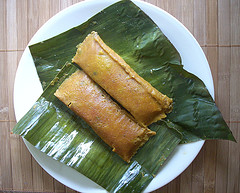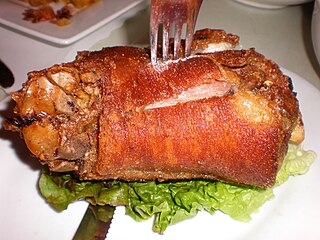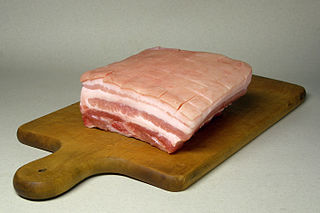
Cajun cuisine, is a style of cooking developed by the Cajun–Acadians who were deported from Acadia to Louisiana during the 18th century and who incorporated West African, French and Spanish cooking techniques into their original cuisine.

A tapa is an appetizer or snack in Spanish cuisine.

Louisiana Creole cuisine is a style of cooking originating in Louisiana, United States, which blends West African, French, Spanish, Amerindian influences, as well as influences from the general cuisine of the Southern United States.

Puerto Rican cuisine has its roots in the cooking traditions and practices of Europe, Africa and the native Taínos. Starting from the latter part of the 19th century. Puerto Rican cuisine can be found in several other countries.

Trinidad and Tobago cuisine is the cuisine of the Caribbean island state of Trinidad and Tobago. It reflects a fusion of African, Creole, Indian-South Asian, Chinese, Amerindian, Arab, European, and Latin American-Spanish-Portuguese cuisines.

Adobo or adobar is the immersion of raw food in a stock composed variously of paprika, oregano, salt, garlic, and vinegar to preserve and enhance its flavor. The Portuguese variant is known as Carne de vinha d'alhos. The practice, native to Iberia, was widely adopted in Latin America, as well as Spanish and Portuguese colonies in Africa and Asia.

Tavče gravče is a traditional Macedonian dish. It is prepared with fresh beans and can be found in many restaurants in North Macedonia. It is also commonly eaten by the Macedonian diaspora. This meal is baked and served in a traditional unglazed earthenware pot. The name of the dish may be translated as "Beans on a tava". Tavče gravče is considered the national dish of North Macedonia. "Tavče gravče Tetovo style" is a popular regional variation.

Pasteles, also known as pastelles in the English-speaking Caribbean, are a traditional dish in several Latin American and Caribbean countries. In Puerto Rico, the Dominican Republic, Trinidad and Tobago, the Caribbean coast of Colombia, and Panama, it looks like a tamale. In Hawaii, they are called pateles in a phonetic rendering of the Puerto Rican pronunciation of pasteles, as discussed below.

Gopchang can refer to the small intestines of cattle or to a gui made of the small intestines. The latter is also called gopchang-gui. The tube-shaped offal is chewy with rich elastic fibers. In Korean cuisine, it is stewed in a hot pot, grilled over a barbecue (gopchang-gui), boiled in soup with other intestines (naejang-tang), or made into a sausage (sundae).

Tunisian cuisine, the cuisine of Tunisia, is a blend of Mediterranean and Berber cuisines. Its distinctive spiciness comes from the many civilizations which have ruled the land now known as Tunisia: Romans, Vandals, Byzantines, Arabs, Spanish, Turkish, Italians (Sicilians), French, and the native Punics-Berber people. Many of the cooking styles and utensils began to take shape when the ancient tribes were nomads. Nomadic people were limited in their cooking implements by what pots and pans they could carry with them. The Tunisian tagine is very different from the Algerian or Moroccan dish. It is a type of a pie dish, made out of eggs, meat and vegetables, similar to the Italian frittata or the eggah.

Kaldereta or caldereta is a goat meat stew from the Philippines. Variations of the dish use beef, chicken, or pork.

Arroz con gandules is a combination of rice, pigeon peas, and pork, cooked in the same pot with sofrito. This is Puerto Rico's national dish along with roasted pork.

Crispy pata is a Filipino dish consisting of deep fried pig trotters or knuckles served with a soy-vinegar dip. It can be served as party fare or an everyday dish. Many restaurants serve boneless pata as a specialty. The dish is quite similar to the German Schweinshaxe.

Malatang is a common type of Chinese street food. It originated in Sichuan, but it differs mainly from the Sichuanese version in that the Sichuanese version is more similar to what in northern China would be described as hot pot.

Shredded beef is a preparation of beef that features in dishes from various cuisines. Shredded beef is sometimes prepared using beef brisket and chuck roast. Pot roast is also sometimes shredded.

Pork rind is the culinary term for the skin of a pig. It can be used in many different ways.

Hot pot or hotpot, also known as soup-food or steamboat, is a cooking method that originates from China, prepared with a simmering pot of soup stock at the dining table, containing a variety of East Asian foodstuffs and ingredients.

A stew is a combination of solid food ingredients that have been cooked in liquid and served in the resultant gravy. Ingredients in a stew can include any combination of vegetables and may include meat, especially tougher meats suitable for slow-cooking, such as beef, poultry, sausages, and seafood. While water can be used as the stew-cooking liquid, stock is also common. A small amount of red wine is sometimes added for flavour. Seasoning and flavourings may also be added. Stews are typically cooked at a relatively low temperature, allowing flavours to mingle.

















